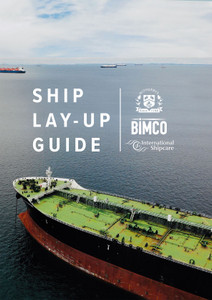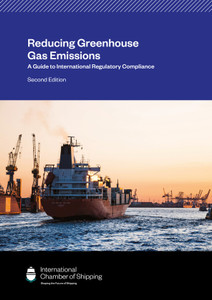
Shipping and the Environment - A Guide to Environmental Compliance
From alternative fuels and propulsion systems, via energy-efficient practices, to digitalisation and efficient logistics, many possibilities are emerging to make the shipping industry a greener industry. Shipping and the Environment gives shipping companies and seafarers a comprehensive entry point into the vast range of regulatory and operational considerations designed to reduce shipping?s environmental footprint. This fifth edition builds on the success of the previous edition, Shipping and the Environment: A Code of Practice, Fourth Edition, which sold more than 10,000 copies.
From alternative fuels and propulsion systems, via energy-efficient practices, to digitalisation and efficient logistics, many possibilities are emerging to make the shipping industry a greener industry. Shipping and the Environment gives shipping companies and seafarers a comprehensive entry point into the vast range of regulatory and operational considerations designed to reduce shipping?s environmental footprint, including:
Key environmental topics related to shipping;
The rules and systems governing them;
How environmental issues are managed at sea and ashore;
How improvements can be delivered at sea and ashore; and
Future developments.
This guide will help crew members understand the relationship between shipping and the environment, and the importance for everyone involved in shipping to respect the environment in their daily operations. Superintendents will benefit from a comprehensive overview of current and upcoming global regulatory framework, including the most recent updates to MARPOL Annex VI, the introduction of the EU Emissions Trading System, and national regulations that affect global shipping. Checklists are included to help shipping companies ensure the safety management system is in line with current environmental requirements, and that all ships are operating in line with environmental regulations.
This fifth edition builds on the success of the previous edition, Shipping and the Environment: A Code of Practice, Fourth Edition, which has sold more than 10,000 copies.
The shipping industry has long been aware of its impact on the environment and has sought to reduce the risks to the environment with regulations and industry best practice. The first environmental regulations for shipping focused on reducing the risk of oil pollution in the sea, but over the years regulations have extended to other forms of environmental protection, for example reducing emissions to air and controlling garbage from shipping.
Over 90% of world trade is carried by sea, and shipping is the most environmentally friendly mode of transporting goods globally.
Ships are critical for global trade, moving goods and people in a safe, economical and efficient way. The industry transports around 11 billion tonnes of cargo each year across oceans, rivers and seas. Without shipping, international trade such as the bulk transport of raw materials and the import/export of affordable food and manufactured goods would simply not be possible.
International environmental shipping standards are constantly improving.
Ships interact with the marine environment, and so the industry?s impacts need to be explored, understood and managed to prevent pollution and harm to the environment. With the rise of global supply chains there have been concerns about the impact on the environment. Shipping is the least environmentally damaging form of commercial transport and, compared with land-based industry, is a comparatively minor contributor to pollution from human activities.
Shipping is constantly adapting to ensure that the seas are looked after as an integral part of how the industry operates and delivers for society, cargo owners and charterers. Understanding and responding to the need to limit environmental impacts, the maritime industry, through the International Maritime Organization (IMO), has been working towards ensuring that the impacts of pollution are reduced.
1.1 What shipping does and how
1.1.1 Global supply chains
Shipping is essential to the functioning of global supply chains, providing businesses with the ability to cost-effectively, efficiently and safely move large volumes of goods and materials as cargo worldwide.
Global supply chains are networks for sourcing and supplying physical goods, and in a globalised economy these networks span continents. A supply chain involves a series of steps involved in delivering a product to the customer, including moving and transforming raw materials into finished products, transporting those products, and distributing them to the end user.
1.1.2 The global fleet
In 2021 the total world fleet amounted to 99,800 commercial ships of 100 gross tonnage (GT) and above, equivalent to a capacity of 2.13 billion deadweight tonnes (dwt).
China, Japan and Greece remain the top three ship-owning countries in terms of cargo-carrying capacity, representing 41% of the global tonnage. Figure 1.1 presents a breakdown of the types of ship in the global fleet in order of dead weight tonnage.
[Figure 1.1: Types of ship and their trade]
Source: UNCTAD calculations, based on data from Clarksons Research.
1.2 Design and building
When a ship is built it has to comply with rules, technical standards and regulations set by both the classification society (see section 2.3.6: Class) and flag state (see section 2.3.3: Flag state). When regulations are brought into effect, these may affect existing ships as well as new ships.
From planning and construction, throughout its trading life, and then to recycling the ship, the environmental impact of the ship is a constant consideration for all those involved.
Once a shipowner decides they wish to build a ship, then classification societies (often referred to as class) ensure the designs, plans and construction are to an approved standard.
1.2.1 Ship operations during a ship?s lifetime
[Figure 1.2: The life cycle of a ship]
Most ships are built in Asia and are recycled in the Indian sub-continent or South East Asia. Throughout a ship?s lifetime, they may trade worldwide.
Flag state and class will continue to check the ship through its life cycle to ensure it is continually certified and complies with relevant laws, including ensuring it is environmentally compliant.
Dry docking takes place approximately every five years, with some ship types being required to dry dock more frequently. Ships will be surveyed while in dry dock.
Port state control will check visiting ships to ensure that they are compliant with international laws. For further information, see section 2.3.4: Port state control.
1 Introduction
1.1 What shipping does and how
1.2 Design and building
2 Controlling and mitigating the risk of marine pollution
2.1 What is marine pollution?
2.2 Sources and effects of marine pollution
2.3 Who regulates the environmental protection laws?
2.4 Categorising marine pollution and the associated laws
3 Shipping company and shipboard best practices
3.1 Environmental, social and governance (ESG) statement
3.2 Training, awareness and competence
3.3 Environmental standards relevant to ISM compliance
3.4 Shipboard Marine Pollution Emergency Plans
3.5 Shipboard documentation
3.6 Technical equipment
3.7 Oily water separators
3.8 Control devices
3.9 Digitalisation options
3.10 Ballast water management
3.11 Hull biofouling
3.12 Underwater noise
3.13 Single-use plastics
3.14 Internal monitoring and reporting of environmental compliance
3.15 Audits of environmental compliance
3.16 External reporting of environmental non-compliance
3.17 Commercial elements
3.18 Shipping finance
3.19 Insurance
3.20 Additional tools and indices
4 Future developments
4.1 Alternative fuels and propulsion methods
4.2 Green corridors
4.3 Grey water
4.4 Black carbon
4.5 Biofouling
4.6 Ship building
4.7 Ship technology, design and construction
4.8 Carbon capture at sea
4.9 Digital transformation
Appendices
The International Chamber of Shipping (ICS) is the principal international trade association for the shipping industry, representing shipowners and operators in all sectors and trades. ICS membership comprises national shipowners' associations in Asia, Europe and the Americas whose member shipping companies operate over 80% of the world's merchant tonnage.
Established in 1921, ICS is concerned with all technical, legal, employment affairs and policy issues that may affect international shipping.
ICS represents shipowners with the various intergovernmental regulatory bodies that impact on shipping, including the International Maritime Organization.
ICS also develops best practices and guidance, including a wide range of publications and free resources that are used by ship operators globally.
https://www.ics-shipping.org/about-ics/
- Number of Pages:
- 88
- Book Height:
- 0 mm
- Book Width:
- 0 mm
- Author:
International Chamber of Shipping
- Publication Date:
- April 2024
- Published Date:
- April 2024





